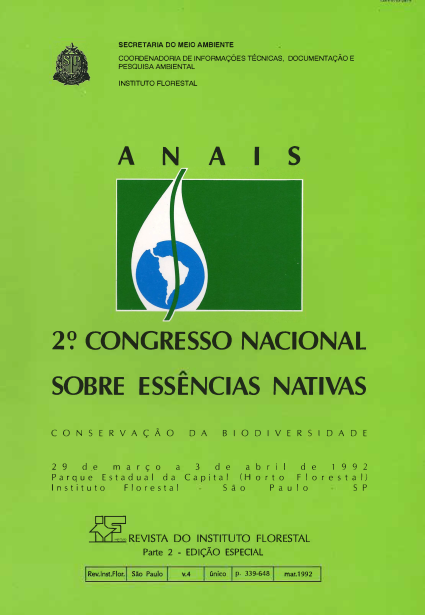CAPACIDADE DE ABSORÇÃO E EFICIÊNCIA NUTRICIONAL DE ALGUMAS ESPÉCIES ARBÓREAS TROPICAIS
DOI:
https://doi.org/10.24278/2178-5031.199242811Keywords:
Nutrient, uptaking, nutritional efficiency, pioneer species, secondary species, climax speciesAbstract
This work had as objectives to study uptake power characteristcs and nutritional efficiency of species of different successional stages. The research was carried out in a nursery and in a reforested are a by the São Paulo Energetic Company along reservoir edges of "Porto Primavera" Hidroelectric Mill. Nine seedlings and two seventeen month old trees, of nine tropical forest species were used. The washed roots of the seedlings and above ground parts were dried, weighted and chemically analysed. Two trees were cut then had their leaves, branches and stems separated. Samples of these componentswere taken in orderto evaluate their chemical composition. The N, P, K and Ca uptake were larger for pioneer species, followed by other species. The uptake rate of these nutrients for ali species were considered much higher in conditions than in nursery conditions. Pioneer species were the most efficient in the nutrient utilization.
Downloads
References
BARTHOLOMEW, W. V.; MEYER, J. & LAUDELOUT, H. Mineral nutrient immobilization under forest and grass fallow in the Yangambi (Belgian Congo) region. Publ. Inst. Etude Agron. Congo Belgue Ser. Sei. n Q 57, 1953,27 p.
BREMMER, J. M. Total nitrogen. In: BLACK, CA (ed.) Methods of soil analysis - Part 2 - Chemical and microbiological properties. Am. SocoAgron., Madison, 1965, p. 1149-78.
BROWN, S. Tropical secondary forests. Journal of Trop. Ecology, 6:1-32, 1990.
BUDOWSKI, A Distribution of tropical American rain forest species in the light of successional progresso Turrialba, 15:40-2, 1965.
GOLLEY, F. B.; McGINNIS, J. T.; CLEMENTS, R. G.; CHILD, G. L. & DUEVER, M. J. Mineral cycling in a tropical moist forest ecosystem. University of Georgia Press, Athens, 1975.
GÓMEZ-POMPA, A G. & VÁZQUEZ-YANES, C. V. Successional studies of a rain forest in Mexico. In: WEST, D.C.; SHUGART, H.H. & BOTKIN, D.B. (eds.) Forest Sucession - Concepts and Application, New York, Springer-Verlag Pre~s, 1981. pp. 247-266.
GONÇALVES,J. L. M.; FREIXEDAS, V. M.; KAGEYAMA, P. Y.; GONÇALVES, J. C. & DIAS, J. H. Produção de biomassa e sistema radicular de espécies de diferentes estágios sucessionais. Anais 2 Q Congresso Nacional sobre Essências Nativas, 1992.
GREENLAND, D. J. & KOWAL, J. M. L. Nutrientcontent of the moist tropical forest of Ghana. Plant and Soil, 12:154-174,1980.
GREENLAND, D. J. The physics and chemistry of the soil-root interface: some comments.ln HARLEY, J.L. & RUSSEL, R.S. (eds.). The soil-root interface. Academic Press, New York, 1979, pp. 83-89.
HEWITT, J. S. & DEXTER, AR. An improved model of root growth in structured soil, Plant and Soil, 52:325- 343,1979.
RAIJ, B. van; QUAGGIO, J. A; CANTARELLA, H.; FERREIRA, M. E.; LOPES, A S. & BATAGLlA, O. C. Análise química do solo para fins de fertilidade. Campinas, Fundação Cargill, 1987, 170 p.
SNEDAKER, S .C. Successional immobilization of nutrients and biologically mediated recycling in tropical forests. In: EWEL, J. (ed.) Tropical succession. Biotropica (Supplement), Washington, 12:16-22, 1980.
VETTORI, L. & PIERANTONY, H.Análise granulométrica: método para determinar a fração da argila. Rio de Janeiro, Equipe de Pedologia e Fertilidade do Solo, 1968,8 p. (Boletim Técnico nQ 3).
WILLlANS-LlNERA, G. W. Biomass and nutrientcontent in two successional stages of tropical wet forest in Uxpanapa, Mexico. Biotropica, Washington, 15(4):275-284,1983.















